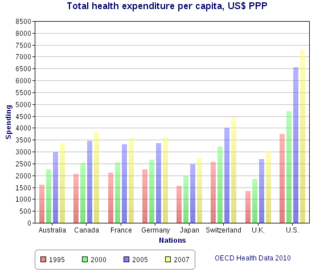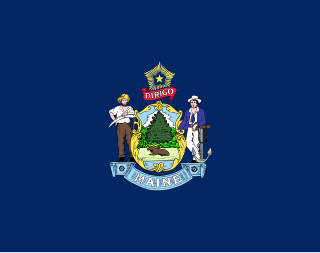Health care reform- is for the most part, governmental policy that affects health care delivery in a given place. Health care reform typically attempts to:

Medicaid in the United States is a federal and state program that helps with medical costs for some people with limited income and resources. Medicaid also offers benefits not normally covered by Medicare, including nursing home care and personal care services. The Health Insurance Association of America describes Medicaid as "a government insurance program for persons of all ages whose income and resources are insufficient to pay for health care." Medicaid is the largest source of funding for medical and health-related services for people with low income in the United States, providing free health insurance to 74 million low-income and disabled people as of 2017. It is a means-tested program that is jointly funded by the state and federal governments and managed by the states, with each state currently having broad leeway to determine who is eligible for its implementation of the program. States are not required to participate in the program, although all have since 1982. Medicaid recipients must be U.S. citizens or qualified non-citizens, and may include low-income adults, their children, and people with certain disabilities. Poverty alone does not necessarily qualify someone for Medicaid.
TennCare is the state Medicaid program in the U.S. state of Tennessee. TennCare was established in 1994 under a federal waiver that authorized deviations from the standard Medicaid rules. It was the first state Medicaid program to enroll all Medicaid recipients in managed care. When first implemented, it also offered health insurance to other residents who did not have other insurance. Over time, the non-Medicaid component of the program was significantly reduced.

Comparison of the healthcare systems in Canada and the United States is often made by government, public health and public policy analysts. The two countries had similar healthcare systems before Canada changed its system in the 1960s and 1970s. The United States spends much more money on healthcare than Canada, on both a per-capita basis and as a percentage of GDP. In 2006, per-capita spending for health care in Canada was US$3,678; in the U.S., US$6,714. The U.S. spent 15.3% of GDP on healthcare in that year; Canada spent 10.0%. In 2006, 70% of healthcare spending in Canada was financed by government, versus 46% in the United States. Total government spending per capita in the U.S. on healthcare was 23% higher than Canadian government spending, and U.S. government expenditure on healthcare was just under 83% of total Canadian spending though these statistics don't take into account population differences.
The term managed care or managed healthcare is used in the United States to describe a group of activities ostensibly intended to reduce the cost of providing for profit health care and providing health insurance while improving the quality of that care. It has become the essentially exclusive system of delivering and receiving American health care since its implementation in the early 1980s, and has been largely unaffected by the Affordable Care Act of 2010.
...intended to reduce unnecessary health care costs through a variety of mechanisms, including: economic incentives for physicians and patients to select less costly forms of care; programs for reviewing the medical necessity of specific services; increased beneficiary cost sharing; controls on inpatient admissions and lengths of stay; the establishment of cost-sharing incentives for outpatient surgery; selective contracting with health care providers; and the intensive management of high-cost health care cases. The programs may be provided in a variety of settings, such as Health Maintenance Organizations and Preferred Provider Organizations.
The Dirigo Health Agency was a government agency run by the state of Maine in the United States. It oversees the state's subsidized health insurance program, DirigoChoice. The program was launched in 2005, and takes its name from the state motto of Maine, Dirigo, which is a Latin phrase meaning "I Lead." The program ended December 31, 2013 with the implementation of the Affordable Care Act.
The Commonwealth of Massachusetts passed a health care reform law in 2006 with the aim of providing health insurance to nearly all of its residents. The law mandated that nearly every resident of Massachusetts obtain a minimum level of insurance coverage, provided free and subsidized health care insurance for residents earning less than 150% and 300%, respectively, of the federal poverty level (FPL) and mandated employers with more than 10 full-time employees provide healthcare insurance. The law was amended significantly in 2008 and twice in 2010 to make it consistent with the federal Affordable Care Act. Major revisions related to health care industry price controls were passed in August 2012, and the employer mandate was repealed in 2013 in favor of the federal mandate. Because Mitt Romney was the governor of Massachusetts at the time, the law has colloquially been called Romneycare, a reference to the nicknaming of the Patient Protection and Affordable Care Act as "Obamacare".
Health insurance in the United States is any program that helps pay for medical expenses, whether through privately purchased insurance, social insurance, or a social welfare program funded by the government. Synonyms for this usage include "health coverage", "health care coverage", and "health benefits". In a more technical sense, the term "health insurance "is used to describe any form of insurance providing protection against the costs of medical services. This usage includes private insurance and social insurance programs such as Medicare, which pools resources and spreads the financial risk associated with major medical expenses across the entire population to protect everyone, as well as social welfare programs like Medicaid and the Children's Health Insurance Program, which both provide assistance to people who cannot afford health coverage.
Healthcare reform in the United States has a long history. Reforms have often been proposed but have rarely been accomplished. In 2010, landmark reform was passed through two federal statutes enacted in 2010: the Patient Protection and Affordable Care Act (PPACA), signed March 23, 2010, and the Health Care and Education Reconciliation Act of 2010, which amended the PPACA and became law on March 30, 2010.

Health insurance coverage in the United States is provided by several public and private sources. During 2016, the U.S. population overall was approximately 325 million, with 53 million persons 65 years of age and over covered by the federal Medicare program. The 272 million non-institutional persons under age 65 either obtained their coverage from employer-based or non-employer based sources, or were uninsured. Approximately 15 million military personnel received coverage through the Veteran's Administration and Military Health System. During the year 2016, 91.2% of Americans had health insurance coverage. Despite being among the top world economic powers, the US remains the sole industrialized nation in the world without universal health care coverage.
Healthy San Francisco is a health access program launched in 2007 to subsidize medical care for uninsured residents of San Francisco, California. The program's stated objective is to bring universal health care to the city. Healthy San Francisco is not a true insurance program, as it does not cover services such as dental and vision care, and only covers services received in the city and county of San Francisco. The program itself acknowledges its limitations, and has stated that "insurance is always a better choice." Healthy San Francisco represents the first time a local government has attempted to provide health insurance for all of its constituents. The program is open to low-income city residents over the age of 18 who do not qualify for other public coverage, and who have had no insurance for at least 90 days. Eligibility is not conditional on citizenship, immigration, employment or health status. The program covers a range of services, but only pays providers within San Francisco. By July 2010, almost 90% of the uninsured adults in San Francisco — over 50,000 people — had enrolled in Healthy San Francisco.
In the United States, health insurance marketplaces, also called health exchanges, are organizations in each state through which people can purchase health insurance. People can purchase health insurance that complies with the Patient Protection and Affordable Care Act at ACA health exchanges, where they can choose from a range of government-regulated and standardized health care plans offered by the insurers participating in the exchange.
The healthcare reform debate in the United States has been a political issue focusing upon increasing medical coverage, decreasing costs, insurance reform, and the philosophy of its provision, funding, and government involvement.
There were a number of different health care reforms proposed during the Obama administration. Key reforms address cost and coverage and include obesity, prevention and treatment of chronic conditions, defensive medicine or tort reform, incentives that reward more care instead of better care, redundant payment systems, tax policy, rationing, a shortage of doctors and nurses, intervention vs. hospice, fraud, and use of imaging technology, among others.

The Patient Protection and Affordable Care Act (PPACA), often shortened to the Affordable Care Act (ACA) or nicknamed Obamacare, is a United States federal statute enacted by the 111th United States Congress and signed into law by President Barack Obama on March 23, 2010. Together with the Health Care and Education Reconciliation Act of 2010 amendment, it represents the U.S. healthcare system's most significant regulatory overhaul and expansion of coverage since the passage of Medicare and Medicaid in 1965.
Health care in the United States is provided by many distinct organizations. Health care facilities are largely owned and operated by private sector businesses. 58% of US community hospitals are non-profit, 21% are government owned, and 21% are for-profit. According to the World Health Organization (WHO), the United States spent $9,403 on health care per capita, and 17.1% on health care as percentage of its GDP in 2014. Healthcare coverage is provided through a combination of private health insurance and public health coverage. The United States does not have a universal healthcare program, unlike other advanced industrialized countries.
In the United States, the chargemaster, also known as charge master, or charge description master (CDM), is a comprehensive listing of items billable to a hospital patient or a patient's health insurance provider. In practice, it usually contains highly inflated prices at several times that of actual costs to the hospital. The chargemaster typically serves as the starting point for negotiations with patients and health insurance providers of what amount of money will actually be paid to the hospital. It is described as "the central mechanism of the revenue cycle" of a hospital.
Health care finance in the United States discusses how Americans obtain and pay for their healthcare, and why U.S. healthcare costs are the highest in the world based on various measures.





